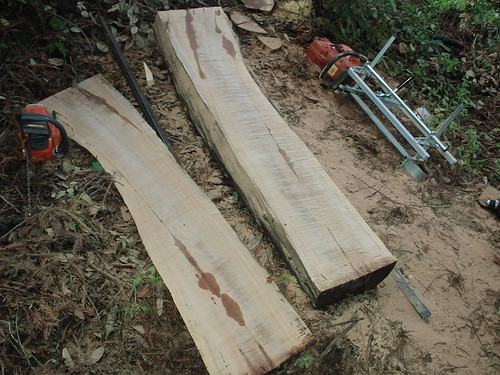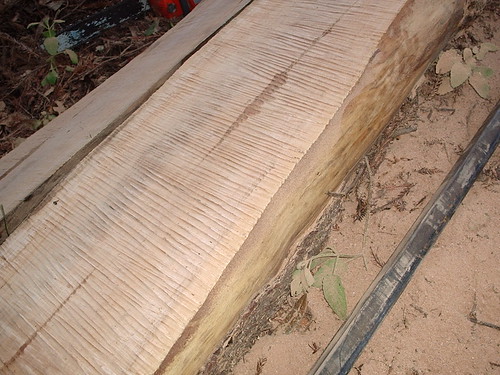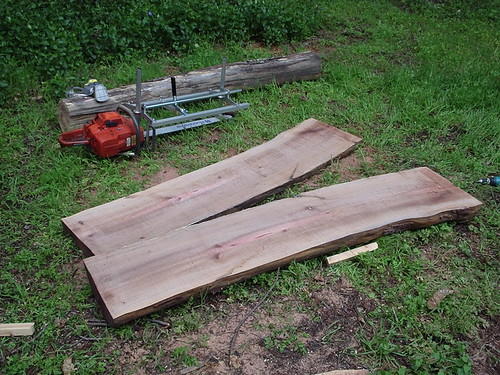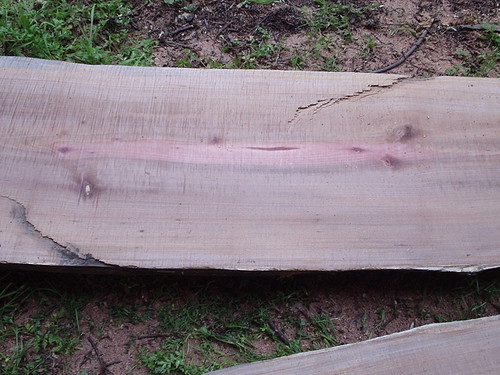LAndrews
ArboristSite Operative
Okay, I finally got the 395 back together and running sorta okay, still need to get the high speed carb setting right. I got lazy and just bought a Granberg - wanted to build my own CSM but will save that project for later. Setup a 'ladder' with sq. steel tubes that stayed remarkably flat with the weight of the saw on them. Anyway...got to where I did my first cut late this afternoon and it seemed to go okay. At least, I thought it went okay until I flipped the top section over.


Don't know how obvious it is, but the cut started off nice and flat and got progressively wavier - there's 1/4" scallops at the end of the cut. Now I'm trying to figure out what contributes to waviness in the cut and what I can do to fix it.
I know the chain is tired. It's a Stihl .404/.063 full skip with about 25% of usable tooth left. The guy I bought the saw from did a pretty good job keeping the gullets clear and the chain still seems sharp but it just doesn't seem to cut like it should.
I know the chain got a bit loose, but didn't seem too bad. It started off where I could pull the driver about half-way out of the bar, seems ok but maybe a little tight. Wound up able to pull the driver out of the bar about 1/4".
Thought I could have done a better job of keeping the CSM flat on the steel rails, and know I should have just pushed the saw through rather than wobbling my way through with my usual front-of-bar then root-of-bar CS technique. It's clear where the cuts cross, but the waviness just follows and doesn't appear to be caused by that motion.
I was *really* impressed with the 395. Really something to let it cool for a bit mid-cut and then just pull the trigger. No BS whatsoever, just get-er-done.
Would appreciate any insights that people can offer. Really want to get the next cuts right.


Don't know how obvious it is, but the cut started off nice and flat and got progressively wavier - there's 1/4" scallops at the end of the cut. Now I'm trying to figure out what contributes to waviness in the cut and what I can do to fix it.
I know the chain is tired. It's a Stihl .404/.063 full skip with about 25% of usable tooth left. The guy I bought the saw from did a pretty good job keeping the gullets clear and the chain still seems sharp but it just doesn't seem to cut like it should.
I know the chain got a bit loose, but didn't seem too bad. It started off where I could pull the driver about half-way out of the bar, seems ok but maybe a little tight. Wound up able to pull the driver out of the bar about 1/4".
Thought I could have done a better job of keeping the CSM flat on the steel rails, and know I should have just pushed the saw through rather than wobbling my way through with my usual front-of-bar then root-of-bar CS technique. It's clear where the cuts cross, but the waviness just follows and doesn't appear to be caused by that motion.
I was *really* impressed with the 395. Really something to let it cool for a bit mid-cut and then just pull the trigger. No BS whatsoever, just get-er-done.
Would appreciate any insights that people can offer. Really want to get the next cuts right.
Last edited:









